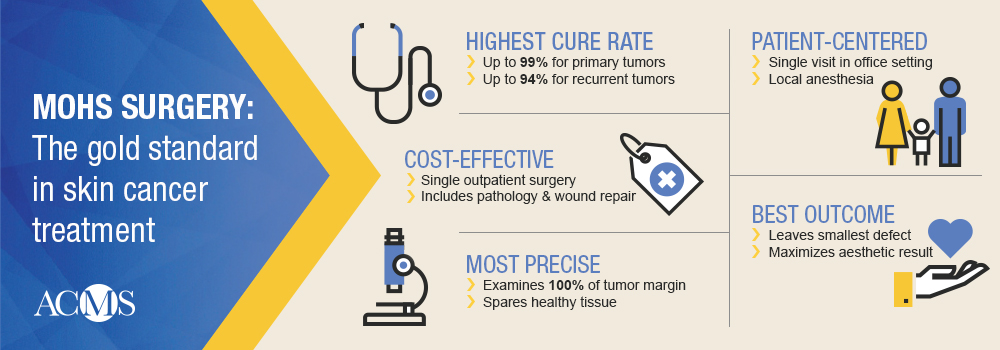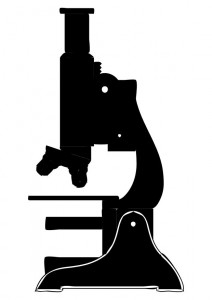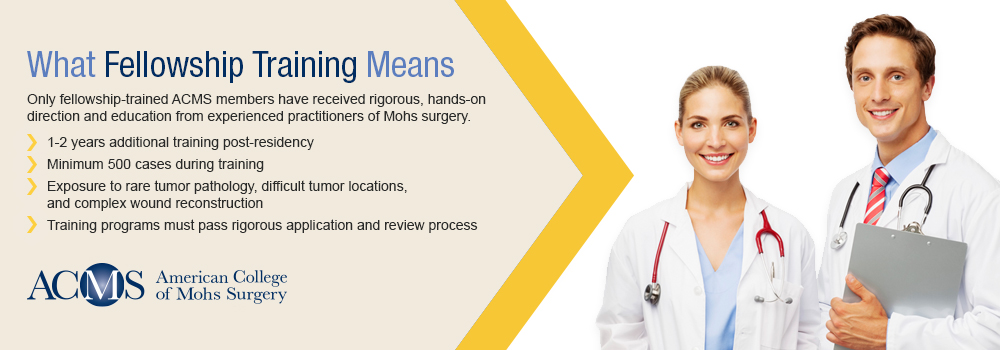
-
ABOUT SKIN CANCER
-
Treatment of Skin Cancers
-
what to expect during surgery
-
watch the Patient educational video

WHAT IS MOHS MICROGRAPHIC SURGERY?
The basic principle behind the Mohs technique is to remove the entire skin cancer
without taking any more normal skin than is absolutely necessary.
Mohs micrographic surgery is a highly specialized, state-of-the-art technique used for the treatment of complex skin cancers. This procedure was first developed in the 1930s by Dr. Frederic E. Mohs, a professor of surgery at the University of Wisconsin. The technique has been refined over the years and is widely accepted as an effective and precise method of removing skin cancer cells while preserving as much healthy tissue as possible. The name micrographic comes from micro, indicating the use of a microscope, and graphic, indicating that a detailed map or drawing of the tumor is made during the treatment.
Mohs micrographic surgery is distinct from routine surgical excision. With the Mohs technique, surgically removed tissue is carefully mapped, dolor-coded, and thoroughly examined microscopically by the surgeon on the same day of surgery. The basic principle behind the Mohs’ technique is to examine 100% of tissue margins to ensure that the tumor is completely removed prior to repair of the skin defect. Mohs micrographic surgery therefore results in the highest cure rate for complex skin cancers while minimizing the removal of normal tissue.
Unlike Mohs, standard surgical excision allows for delayed examination of approximately 1% of tissue margins. Since only a small percentage of margins are evaluated, residual tumor may be missed. If more cancer cells are found to remain during delayed pathologic examination, a second surgical procedure will be required at a later date.
The Mohs procedure requires the following three steps:
1) remove the visible tumor to determine the initial tumor borders
2) remove a thin disk of skin around and underneath these borders
3) examine the removed skin under a microscope and draw a map of where any skin cancer remains
If cancer is still present, we will remove only that skin where the cancer remains. These steps are repeated in stages until the tumor is totally removed. In this way, a careful, accurate, and complete removal of the skin cancer is achieved with minimal removal of normal surrounding skin.
There are a number of special circumstances when the Mohs surgery technique is modified to accommodate issues that go beyond traditional “tissue sparing”. Tumors such as melanoma, Merkel cell carcinoma, malignant fibrous histiocytoma, dermatofibrosarcoma protuberans, and others can be aggressive and life threatening. In this event, our emphasis is based on complete tumor removal with an appropriate wide local margin, followed immediately by the first Mohs layer. This sequence is performed to achieve the highest possible confidence level that the resultant skin defect site can be repaired immediately in the confident knowledge that the entire tumor has been resected.
ADVANTAGES OF MOHS SURGERY
Your doctor has recommended that your skin cancer be treated using the Mohs surgical technique. Mohs micrographic surgery is a highly specialized surgical technique which requires a trained team of medical personnel. Since Mohs’ surgery can be time consuming and labor intensive, it is reserved only for certain complex basal and squamous cell carcinomas. In some circumstances, Mohs surgery can be used to treat less common tumors, including some superficial melanomas.
Skin cancers are complex when:
- the cancer is in an area where preservation of healthy tissue is critical to maximize function and cosmetic result (eyelids, nose, ears, lips, hands, genitals)
- the cancer is in an area of higher tumor recurrence (ears, lips, nose, eyelids, temples)
- the cancer has been previously treated and has come back (recurred)
- the cancer is large
- the edges of the cancer cannot be clearly defined
- scar tissue exists in the area of the cancer
- the cancer grows in an area of prior radiation therapy
- the patient is immunosuppressed (organ transplant, HIV infection, chronic lymphocytic leukemia)
- the patient is prone to getting multiple skin cancers (including genetic syndromes such as basal cell nevus syndrome and xeroderma pigmentosa
THE ADVANTAGE OF MOHS SURGERY
The Mohs technique has a number of advantages over other methods of skin cancer treatment. Because no guesswork is involved in determining where the cancer’s edge lies, a minimum of normal skin is excised and only the tissue involved with cancer is removed. In other words, the cancer is completely removed while normal tissues are conserved. This procedure results in the smallest possible tissue defect and therefore, the smallest possible scar. During Mohs surgery, the surgeon acts as the pathologist and immediately examines the removed tissue. The surgeon can directly compare what is seen on the patient’s skin and under the microscope. This is not the case when the tissue is sent to an outside pathologist for interpretation.
Mohs Surgery is a tissue-sparing technique that offers several advantages over other treatments:
- The highest cure rate of any treatment for skin cancer
- The smallest amount of normal skin is removed maximizing functioning and minimizing scaring
- Fewer risks since it is done in the office – no hospitalization and no general anesthesia.
WHY CHOOSE A FELLOWSHIP TRAINED MOHS SURGEON?
Mohs micrographic surgery has set a new standard in skin cancer treatment. An increasing number of physicians are performing Mohs surgery, which is now widely accepted as the most effective treatment for most types of skin cancer. However, not all Mohs surgeons receive the same level of training as Dr. Margaret Mann, a fellowship trained Mohs surgeon.
The Mohs College Difference
When it comes to your skin cancer treatment, you deserve no less than the best. Dr. Mann has achieved the highest degree of Mohs surgery qualification by completing an American College of Mohs Surgery approved fellowship. For you, this means peace of mind, knowing that you will receive superior quality and competency, as well as an optimal outcome.
Dr. Mann and the American College of Mohs Surgery – Committed to Superior Care
The American College of Mohs Surgery (http://www.skincancermohssurgery.org/) was established by Dr. Frederic Mohs himself, and its fellowship training program is generally acknowledged as the benchmark in Mohs surgery training. Through an extensive application and interview process, only the most qualified physicians are selected by ACMS to participate in a fellowship program. Participants must undergo a rigorous 1 to 2 year training program subsequent to completing a residency in dermatology.
During fellowship training, Dr. Mann studied and trained under the guidance of veteran Mohs College surgeons at the Center of Dermatologic and Cosmetic Surgery at Washington University in St. Louis. A cornerstone of the ACMS fellowship training program is cultivating experience and judgment in each graduate. Since skin cancer occurs in a diversity of forms, degrees and locations, the program is set up to be thorough and stringent.
Dr. Mann met the following requirements in completing her ACMS fellowship:
- Participated in a minimum of 500 Mohs surgery cases
- Learned to accurately interpret slides of tissue samples removed during Mohs surgery
- Performed a vast array of reconstructions, ranging from the simplest to the most complex, multi-step repairs
As an ACMS graduate, Dr. Mann gained an uncommon level of exposure, including everything from challenging tumor locations to rare tumor pathology and complex wound reconstruction. You can rest assured that she has the training and experience to achieve the best outcome from your skin cancer treatment.

WILL I DEVELOP MORE SKIN CANCERS?
50% of patients will have a second skin cancer within five years of their first.
After having one skin cancer, statistics say that you have a higher chance of developing a new skin cancer in other areas in the future. The damage that your skin has already received from the sun cannot be reversed. However, there are precautions that can be taken to prevent further skin cancers. They involve good common sense. You should apply sunscreen at least 10 minutes before exposure to sunlight. We recommend that you use a sunscreen with SPF 30 or higher, and reapply sunscreen frequently. A wide-brimmed hat, long-sleeved shirt and other protective clothing are also appropriate. Avoidance of excessive sunshine is recommended.
You should have your skin checked very closely by a physician at six-month intervals. This is not only to check the surgical site as it is healing, but also to check for the development of additional skin cancers. Our policy is that your Mohs surgeon will follow the majority of our patients until the wound has healed. Following completion of post-operative care, you will return to you referring dermatologist for regular skin exams. We recommend six-month follow-up visits for two years, and yearly thereafter if no additional cancers are detected. Of course, any areas of your skin that change, fail to heal, or just concern you should be brought to the attention of your referring physician immediately. Your referring physician will be able to adequately treat most skin cancers when they are detected early and are small.
